Outforia Quicktake: Key Takeaways
- It’s essential to learn to spot the differences between poisonous and edible mushrooms. Many look very similar, making it difficult to tell the poisonous ones from the edible ones.
- Be very cautious when foraging for mushrooms; some can be highly toxic. If you are anything less than 100% certain of any given mushroom’s identity or have any doubts about its safety, do not consume it. It’s always better to err on the side of caution and seek the advice of an experienced mushroom hunter, mycologist, or your local health authorities.
- Observe where mushrooms are found, what trees they live under, and what they grow out of.
- Always go foraging with a professional forager or mycologist for safety.
- Some common poisonous mushrooms include Death Cap, Funeral Bell, and Destroying Angel.
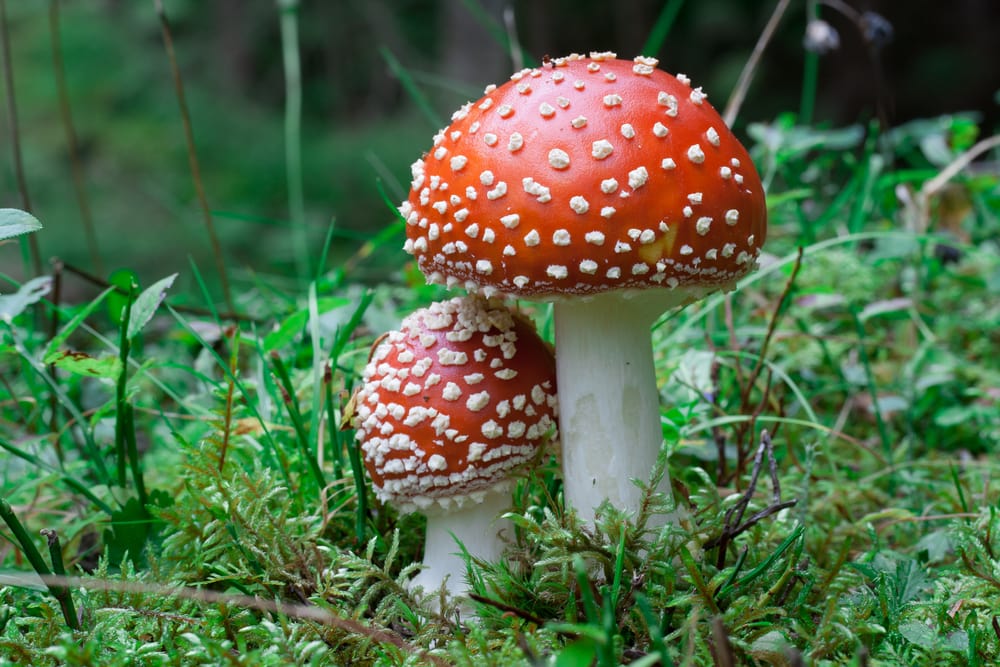
There’s nothing quite like spending the day foraging mushrooms for your meal in woods and grasslands. It pays not to rush things, however.
Fungi are a minefield of tasty mushrooms – as well as toxic ones. Be very observant of where you find a mushroom, what trees it lives under, and what it is growing out of. Don’t just cut it off and run!
We have 22 of the most poisonous mushrooms to avoid listed down below. Learn to spot subtle differences between them and as much as possible, go foraging with a professional forager or a mycologist.
You May Also Like: Unveiling 25+ Stunning Tropical Rainforest Plants: Nature’s Wonders
1. Death Cap (Amanita phalloides)

Mushrooms in the Amanita family, such as the Death Cap, contain dangerous toxins like amatoxins and alpha-amanitin.
It’s important to note that the toxins in Amanita mushrooms are not destroyed by cooking or drying, and even a small amount can be fatal. Therefore, it’s crucial to be absolutely sure of the identification before consuming any wild mushrooms.
The Death Cap looks a lot like the Dirty Tricholoma, which is an edible mushroom. It is often a metallic olive color but can also be white.
Check to see if it is growing out of a volva or a sac at the base. If it is, it’s an Amanita and most likely to be a Death Cap.
If you are unsure of the mushroom’s identity or have any doubts, do not consume it. It’s always better to err on the side of caution and seek the advice of an experienced mushroom hunter, mycologist, or a local expert.
2. Funeral Bell (Galerina marginata)

Known in the US as Autumn Skullcap, this delicate looking small mushroom also contains amatoxins.
Though it looks similar to the Velvet Shank, it has a ring on its stem,which is more tan than brown. It also looks like the edible Honey Fungus and Brown Stew Mushroom.
New research has looked into Funeral Bell’s alpha-amanitin. The genes for this lethal poison have been passed on by another species of now extinct mushroom. This is called gene transfer. It was previously thought that only very simple animals like bacteria could do this.
Here’s how you can identify Funeral Bell mushrooms:
3. Panther Cap (Amanita pantherina)

The Panther Cap is a handsome member of the Amanita family. It has a crust of fine warts on top of the cap that look like panther spots, hence its name.
The Panther Cap’s volva has a defined gutter running around the top. The skirt on the stem is big with no striations or lines on it.
Panther cap – along with Fly Agaric – contains ibotenic acid and muscimol, as well as other toxins which can cause hallucinations, nausea, vomiting, diarrhea, seizures, and in severe cases, death.
The hallucinogenic properties of these mushrooms have been known for centuries and have been used in some cultures for shamanic and spiritual purposes.
4. Lilac Elf Cup (Sarcosphaera coronaria)

The Lilac Elf Cup is a cup-shaped member of the ground-hugging Pezizaceae family. Though it looks like a rock from the outside, it’s a soft lilac inside. Some other members of the Pezizaceae family, like the Orange Peel mushroom, are edible.
The Lilac Elf Cup is common under conifers. It grows In California as well as across Europe and the UK.
Historically, this mushroom was considered edible, but after several fatal poisonings, it was categorized as poisonous.
It’s possible that this hyperaccumulating mushroom takes up and concentrates arsenic in the soil. This has yet to be confirmed, however.
A hyperaccumulator is a type of plant that can absorb and accumulate unusually high levels of certain metals or other toxic substances in their tissues, far beyond what is considered normal for most plants.
5. Deadly Webcap (Cortinarius rubellus)

The Deadly Webcap lives in Scotland and Northern Europe but is fairly rare, which is fortunate! It can be found under pine and spruce trees.
This mushroom has a rusty orange color but can be lighter tan. It has snakeskin markings on the stem.
Cortinarius refers to the veil that covers the gills when the mushroom is young, while rubellus means red.
It contains a potent toxin called orellanine. Orellanine is a nephrotoxin, which means that it can cause damage to the kidneys. It is a heat-stable compound, meaning that cooking or drying the mushroom does not reduce its toxicity.
6. Destroying Angel (Amanita virosa)
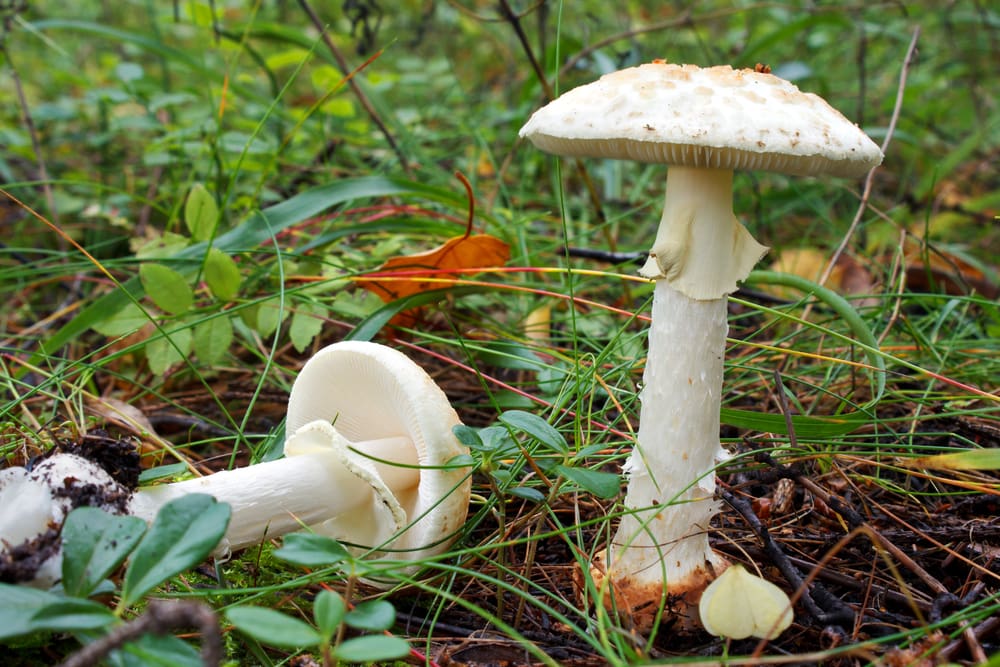
Despite the Destroying Angel’s pure white appearance, nothing about it is heavenly. In fact, it contains the same lethal toxins as the Death Cap. It also smells better than the Death Cap, which smells terrible. Though the Destroying Angel has a faint bad smell, you really have to try hard to smell it.
The tall white stem has peeling layers. It does have a volva, but it’s buried deep in the soil. This is why it’s advisable to always dig down deep at the base of a mushroom with a mushroom knife.
The Destroying Angel is often confused with other white, mushroom species that may appear similar in appearance, such as the edible Meadow Mushroom or the poisonous False Parasol Mushroom.
7. Deadly Dapperling (Lepiota brunneoincarnata)

The Deadly Dapperling is a highly poisonous mushroom that can be found in grassy areas throughout Europe and North America.
It is known for its striking appearance, with a brownish-red cap that is covered in small scales and a white stem with a ring near the top.
In addition to its striking appearance, the Deadly Dapperling can also be identified by a few key features. The cap of the mushroom typically measures between 3-10 cm (1.2-3.9 in) in diameter and is initially rounded before flattening out with age.
The gills on the underside of the cap are crowded and white, turning pink or brown as the mushroom matures.
Its close cousin, the Lepiota subincarnata, is also a deadly little Lepiota. This one lives in Australia under eucalyptus and hardwood trees.
8. The Brown Roll-Rim (Paxillus involutus)

The Brown Roll-Rim is another lethal mushroom that used to be considered edible. It’s a common woodland mushroom that can be found throughout Europe and North America. I myself find these under birches and on acid soil, nestling in bracken.
It has a distinctive brown cap that is convex when young but becomes flattened with age, and its stem is often curved or twisted.
The Brown Roll-Rim is known to accumulate heavy metals and other toxins from its environment.
It’s often found growing in a mycorrhizal relationship with trees. This means it forms a mutually beneficial association with the roots of certain trees.
9. Devil’s Bolete (Rubroboletus satanas)
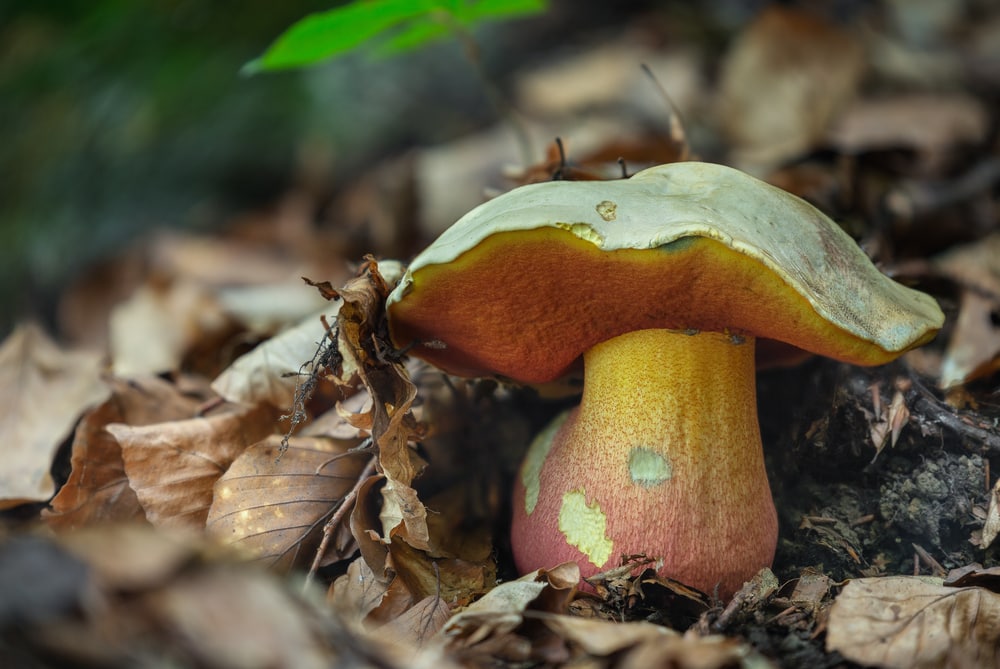
The chunky Devil’s Bolete is a brightly-colored poisonous mushroom. It has a convex cap that is reddish-brown or dark brown in color. The stem is a bright red-orange to yellow and the pores are red. It also smells awful.
The Devil’s Bolete is a large and distinctive bolete found in Europe and parts of Asia. It’s quite rare, however, appearing only in limestone and chalk areas in the UK and Europe.
The Devil’s Bolete mushroom has a symbiotic relationship with the roots of certain trees, and it is often found growing in association with oak, beech, and pine trees. This mushroom has a very distinct appearance, making it relatively easy to identify in the wild.
Poisonings are rare due to the off-putting smell and the giveaway coloration. This is due to a chemical in the mushroom, which is called Bolesatine.
10. The Sickener (Russula emetica)

Emetica means something that will help you vomit, which is an appropriate name for a mushroom such as the Sickener.
The Sickener mushroom’s cap is typically reddish-brown or dark purple in color, and it has a convex or flattened shape. The stem is typically white, cylindrical, and can be up to 3.9 in (10 cm) long. When cut or damaged, the flesh of the Sickener mushroom typically turns a pinkish color.
As implied, Sickener mushrooms can cause terrible stomach aches and diarrhea. Squirrels, however, can happily eat sickener mushrooms with no ill effects!
They’re found in coniferous woodland in the UK, Europe, North Africa, North America, and some Asian countries.
As it’s a Russula, the edges of the cap and the stem are friable, which means it’s as brittle as chalk.
11. Fool’s Webcap (Cortinarius orellanus)

Another of the deadly Webcaps, the Fool’s Webcap also contains the poison orellanine.
The cap is typically reddish-orange or yellowish-brown in color, and it has a convex shape that can become flattened or depressed with age. The stem of the mushroom is typically slim and elongated, and it can be pale yellow or orange-brown in color.
The Fool’s Webcap has a long history of use in folk medicine, particularly in central and northern Europe. The mushroom was used to treat a variety of ailments, including fever, inflammation, and digestive problems.
However, the use of the mushroom in traditional medicine is not recommended due to its toxicity.
In fact, the Fool’s Webcap mushroom is considered one of the most poisonous mushrooms in Europe, and even a small amount can cause serious harm to humans or animals.
12. Ivory Mushroom (Clitocybe dealbata)

The Ivory Mushroom grows in rings in grasslands. It shares the same habitat as the edible Fairy Ring Champignon, which also grows in rings and is the same size.
The Ivory Mushroom is all white while the Champignon is tan. The Ivory Mushroom has an irregular wavy margin in its cap, whilst the Champignon has a regular round-shaped cap.
The gills on the Ivory Mushroom are crowded and decurrent, which means it runs down the stem. On the other hand, the Champignon’s gills are widely spaced.
13. Fly Agaric (Amanita muscaria)
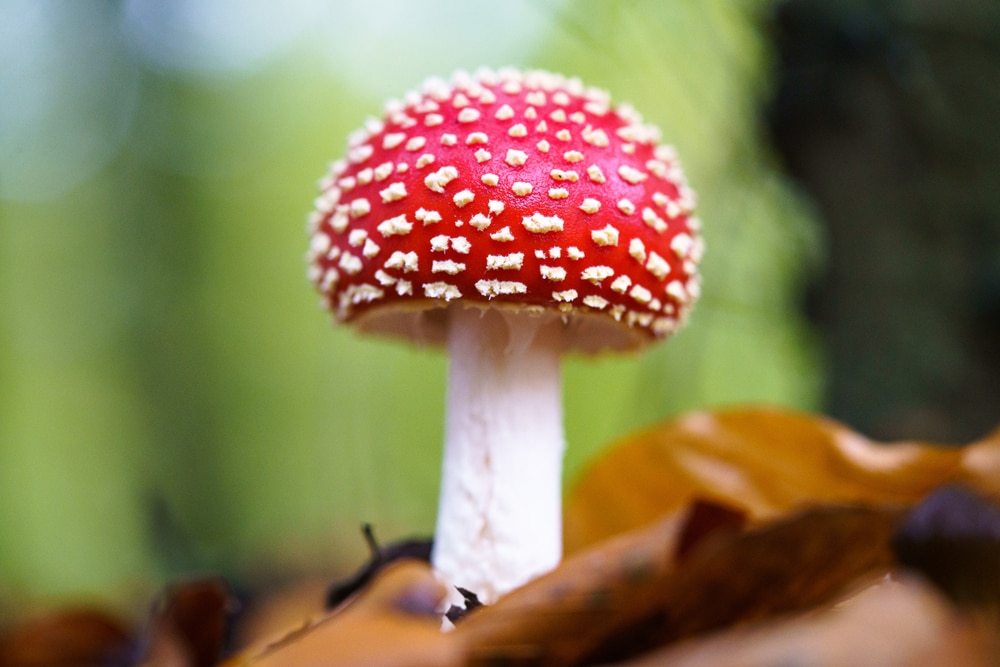
The classic fairy toadstool so beloved in children’s books is actually an Amanita, not an Agaric! It is easy to recognise, with a bright red cap, snow white stem and tiny white warts on top of the cap.
Fly Agaric was once used to kill flies. Pieces of the mushroom were infused in milk, attracting flies then killing them.
Fly Agaric mushrooms contain several toxic compounds, the most significant of which are ibotenic acid, muscimol, and muscarine.
New studies have also found that the two main parts of Fly Agaric can stop people from feeling afraid and startled. This agrees with ideas that the Viking Berserker fighters took Fly Agaric before fighting, which made them feel bolder.
14. Poison Fire Coral (Podostroma cornu-damae)
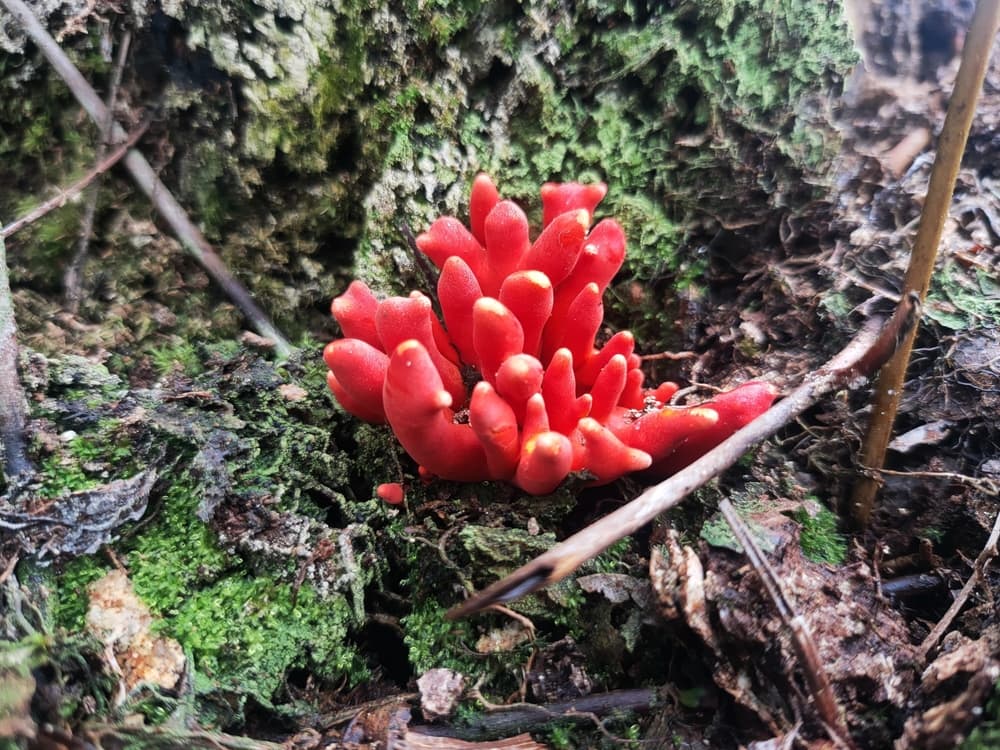
Poison Fire Coral is a type of fungus that typically grows on dead wood in forested areas. It is also known as the “devil’s fingers” or “octopus stinkhorn” due to its unique appearance.
The fruiting body of the fungus consists of a central stalk or “stipe” that is typically around 4-8 cm (1.6-3.1 in) tall and 1-2 cm (0.39-0.79 in) thick.
At the top of the stipe, there are several “arms” or “tentacles” that emerge. These arms are typically bright red or orange in color. These are covered in a sticky, smelly substance that attracts flies and other insects.
The Poison Fire Coral comes from Japan, Korea, and other parts of Asia, where it has been responsible for many poisonings. The poison in this fungus is called trichothecene.
15. Angel’s Wings (Pleurocybella porrigens)

Angel’s Wings is a beautiful pure white bracket fungi that was once a popular edible in Japan. They appear to be consumed in many cases with no ill effects.
The active poison in Angel’s Wings mushrooms was shown to be Pleurocybellaziridine. It’s still uncertain why in many years these mushrooms can be consumed with no harm done.
Also known as “Japanese Angel’s Wings” or “White Rot fungus,” Angel’s Wings caps are typically thin, delicate, and white in color with a smooth or slightly wavy surface. The gills are crowded together, and are also white or cream-colored.
The stem of the mushroom is typically thin and long, and can range in color from white to pale yellow. It is often slightly curved or twisted, and has a tough, fibrous texture.
Angel’s Wings mushrooms have a distinctive odor, which has been described as slightly sweet or like burnt sugar.
16. Earthball (Scleroderma)

Earthballs are a type of mushroom that are found in many different parts of the world. They are also known as “pigskin poison puffballs” or “false truffles”. These mushrooms are typically spherical or roughly spherical in shape, and range in size from a few centimeters to several centimeters in diameter.
Earthballs are leathery, generally stemless fungi. They are black inside and have a leathery, cracked look. When they mature, they explode in a cloud of black spores.
They can be mistaken for Puffball mushrooms, which are a stalkless, common edible. However, Puffballs have a tiny hole in the cap where Earthballs don’t.
Common Earthballs are parasitized by Pseudoboletus parasiticus, a tiny bolete fungus that lives inside them.
17. Jack-o’-Lantern (Omphalotus)
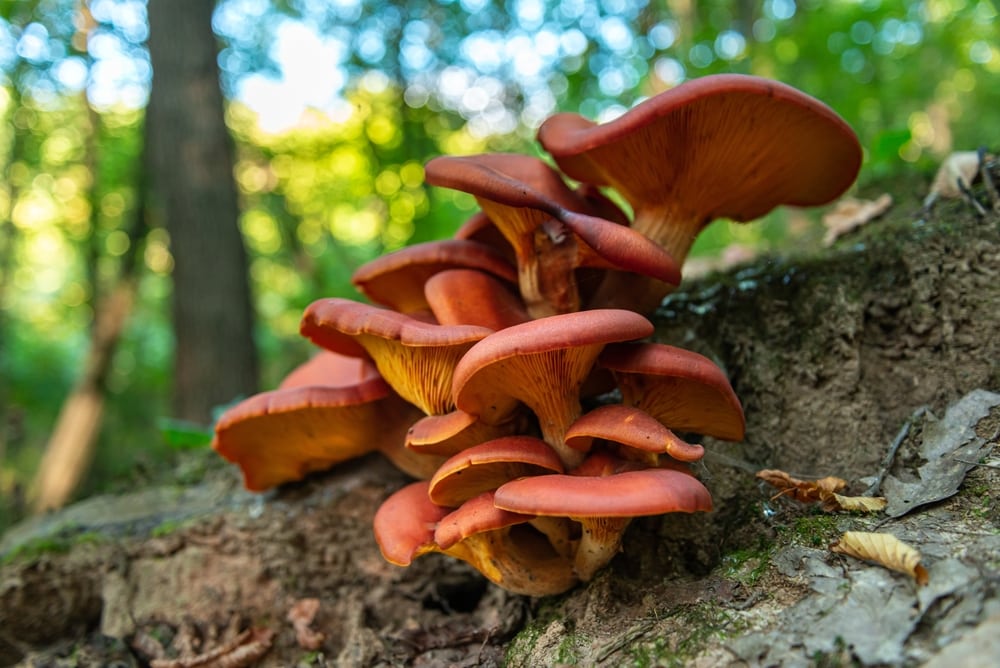
Jack-o’-Lantern is the common name for several species of mushrooms in the genus Omphalotus. They’re also known as “false chanterelles” or “gilled mushrooms”.
They are bright orange and trumpet-like with strongly decurrent gills. They tend to grow in large clusters on the trunks and stumps of trees.
Jack-o’-Lanterns are often mistaken for Chanterelles, a good edible. Jack-o’-Lanterns are not good to eat, however, and can cause stomach upsets.
Some of these mushrooms are bioluminescent, earning them the name of Jack-o’-Lantern! Bioluminescence means that they emit light, which is pretty handy at night.
18. Liberty Caps (Psilocybe semilanceata)

Liberty Caps are famous for being highly hallucinogenic. They are also known as “magic mushrooms” or “psilocybin mushrooms” due to the psychoactive compounds they contain. Psilocybin is the active ingredient in Liberty Caps.
The caps are typically conical or bell-shaped, which is why they’re also called “pixie hats.” The color can vary depending on its age and environmental conditions, but is typically a reddish-brown or yellowish-brown color, with a distinctive nipple-shaped protrusion at the top.
The gills on the underside of the cap are closely spaced and are a pale gray color. The stem of the mushroom is typically thin and elongated and the mushroom’s flesh is thin and fragile.
Interestingly, Liberty Caps bruise blue when handled or damaged. This is due to the presence of psilocin and psilocybin in the mushrooms.
Liberty Caps are found where sheep graze tufted grass. They are common in the UK, North America, Ireland, and Europe.
19. Sulfur Tuft (Hypholoma fasciculare)

Sulfur Tuft are a common and widespread type of mushroom that is found in many parts of the world, usually in massive clumps on decaying trees. They are also known by several other common names, including “sulfur knight”, “sulfur fungi”, and “clustered woodlover”.
The caps of sulfur tuft mushrooms are typically small and are usually bright yellow to orange in color. The caps are convex at first, but become flatter as they mature, with a slightly depressed center.
The gills on the underside of the cap are crowded together and are initially yellow. They eventually darken to a brownish-black color as the mushroom matures.
The stem of the sulfur tuft mushroom is typically long and slender, and ranges in color from yellow to brownish-gray. The flesh of the mushroom is thin and has a bitter taste.
Despite its toxicity, Sulfur Tuft has been useful. It is used to keep other more harmful fungi out of trees.
20. Fool’s Mushroom or European Springtime Destroying Angel (Amanita verna)

Fool’s Mushroom is a deadly mushroom that can be found in China, Europe, and the UK. It looks very similar to Destroying Angel. However, there are tiny differences between the two Amanitas under the microscope.
The cap is white with a smooth and slightly sticky surface often covered in small, fine scales. The gills on the underside of the cap are white and closely spaced.
The stem is also usually white. It’s often slightly bulbous at the base, with a ring or skirt-like structure known as the “annulus” located near the top of the stem. The flesh of the mushroom is white and does not change color when cut or bruised.
21. Brain Mushroom or False Morel (Gyromitra esculenta)

The Brain Mushroom looks just like a brain, and superficially resembles the very tasty Morel. Although Esculenta means “good to eat,” the Turban Fungus is too deadly to be edible.
The cap is irregularly shaped and typically brown in color, with a wrinkled or brain-like appearance. The stem is typically short and thick, and is often fused to the cap in a saddle-like shape.
Brain Mushrooms are not considered to be edible when raw, as they contain a toxin called gyromitrin. However, some people in certain regions of the world have traditionally eaten these mushrooms after boiling or parboiling them to remove the toxins.
It’s important to note that the cooking process does not completely remove the toxins, and consuming these mushrooms is not recommended due to the risk of toxicity.
Weirdly, in some areas, like Eastern Europe, it has a higher level of toxicity than in other areas, like North America! Moreover, Brain Mushrooms found high in the mountains are less poisonous than those found in lowland areas.
22. Poison Pie (Hebeloma crustuliniforme)
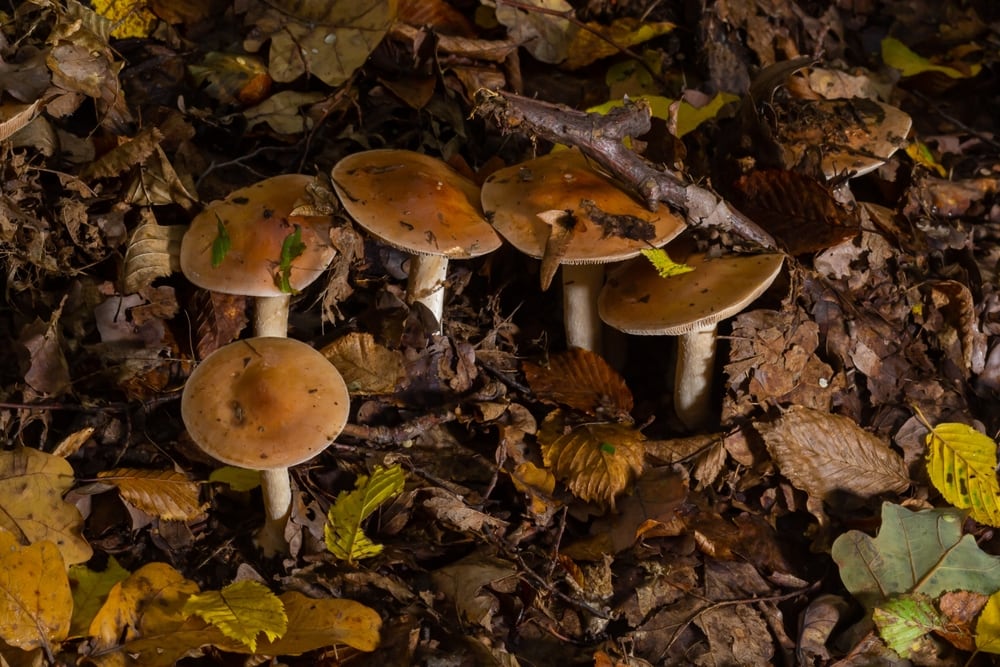
Poison Pie is an aptly-named mushroom bearing a strong smell of radishes. The name Hebeloma comes from the Greek hebe meaning “youth” and loma meaning “veil.” This mushroom only keeps its veil for a short time.
It’s a small to medium-sized mushroom with a cap that is initially conical and later flattens out, becoming slightly depressed in the center. The color of the cap ranges from yellow-brown to reddish-brown and is often covered with fine fibrils that give it a velvety texture.
It can be found under broadleaf and conifer trees. Moreover, the spores are rust brown and almond-shaped if you look at them under a microscope!
The name Hebeloma comes from the Greek hebe meaning “youth” and loma meaning “veil.” This mushroom only keeps its veil for a short time.
You May Also Like: Unraveling The Berry Mystery: Are Strawberries Berries?
Poisonous Mushrooms FAQs

What’s the most common deadly mushroom?
The Destroying Angel (Amanita virosa) is the most common deadly poisonous fungus worldwide.
What’s the most toxic mushroom?
The Death Cap is the most toxic mushroom due to its high concentrations of alpha-amanitin. It has a mortality rate as high as 50%. Alpha amanitin is not destroyed by cooking as many other mushroom toxins are.
How many species of lethally poisonous mushroom are there?
There are around 30 species of lethal mushroom worldwide. However, new species of mushroom are being discovered all the time!








